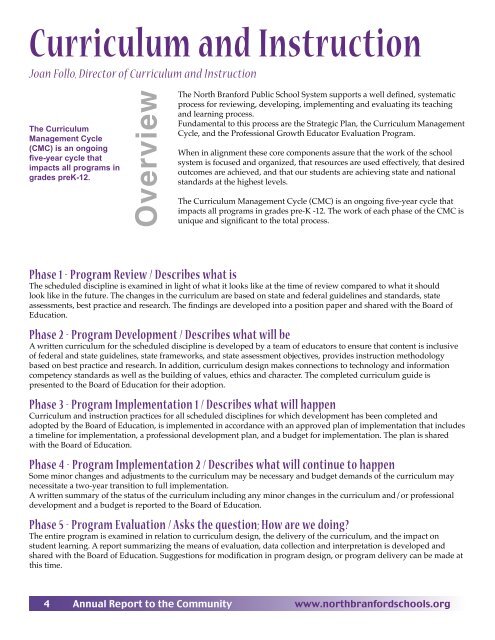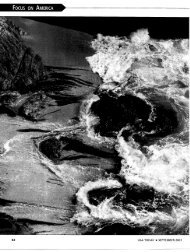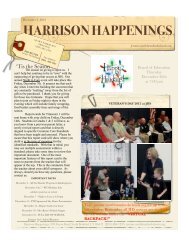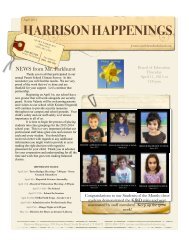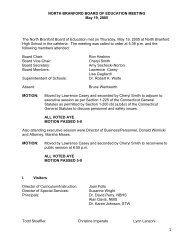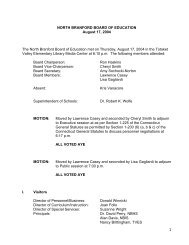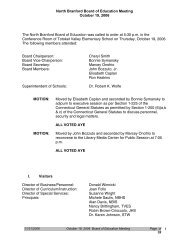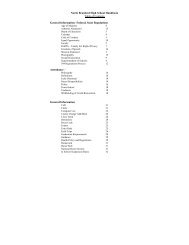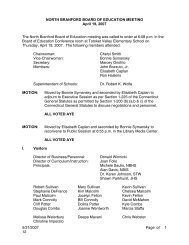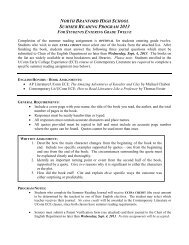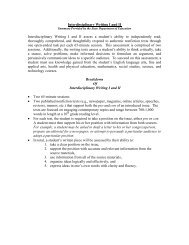Annual Report of the Superintendent - North Branford Public Schools
Annual Report of the Superintendent - North Branford Public Schools
Annual Report of the Superintendent - North Branford Public Schools
Create successful ePaper yourself
Turn your PDF publications into a flip-book with our unique Google optimized e-Paper software.
Curriculum and Instruction<br />
Joan Follo, Director <strong>of</strong> Curriculum and Instruction<br />
The Curriculum<br />
Management Cycle<br />
(CMC) is an ongoing<br />
five-year cycle that<br />
impacts all programs in<br />
grades preK-12.<br />
Overview<br />
The <strong>North</strong> <strong>Branford</strong> <strong>Public</strong> School System supports a well defined, systematic<br />
process for reviewing, developing, implementing and evaluating its teaching<br />
and learning process.<br />
Fundamental to this process are <strong>the</strong> Strategic Plan, <strong>the</strong> Curriculum Management<br />
Cycle, and <strong>the</strong> Pr<strong>of</strong>essional Growth Educator Evaluation Program.<br />
When in alignment <strong>the</strong>se core components assure that <strong>the</strong> work <strong>of</strong> <strong>the</strong> school<br />
system is focused and organized, that resources are used effectively, that desired<br />
outcomes are achieved, and that our students are achieving state and national<br />
standards at <strong>the</strong> highest levels.<br />
The Curriculum Management Cycle (CMC) is an ongoing five-year cycle that<br />
impacts all programs in grades pre-K -12. The work <strong>of</strong> each phase <strong>of</strong> <strong>the</strong> CMC is<br />
unique and significant to <strong>the</strong> total process.<br />
Phase 1 - Program Review / Describes what is<br />
The scheduled discipline is examined in light <strong>of</strong> what it looks like at <strong>the</strong> time <strong>of</strong> review compared to what it should<br />
look like in <strong>the</strong> future. The changes in <strong>the</strong> curriculum are based on state and federal guidelines and standards, state<br />
assessments, best practice and research. The findings are developed into a position paper and shared with <strong>the</strong> Board <strong>of</strong><br />
Education.<br />
Phase 2 - Program Development / Describes what will be<br />
A written curriculum for <strong>the</strong> scheduled discipline is developed by a team <strong>of</strong> educators to ensure that content is inclusive<br />
<strong>of</strong> federal and state guidelines, state frameworks, and state assessment objectives, provides instruction methodology<br />
based on best practice and research. In addition, curriculum design makes connections to technology and information<br />
competency standards as well as <strong>the</strong> building <strong>of</strong> values, ethics and character. The completed curriculum guide is<br />
presented to <strong>the</strong> Board <strong>of</strong> Education for <strong>the</strong>ir adoption.<br />
Phase 3 - Program Implementation 1 / Describes what will happen<br />
Curriculum and instruction practices for all scheduled disciplines for which development has been completed and<br />
adopted by <strong>the</strong> Board <strong>of</strong> Education, is implemented in accordance with an approved plan <strong>of</strong> implementation that includes<br />
a timeline for implementation, a pr<strong>of</strong>essional development plan, and a budget for implementation. The plan is shared<br />
with <strong>the</strong> Board <strong>of</strong> Education.<br />
Phase 4 - Program Implementation 2 / Describes what will continue to happen<br />
Some minor changes and adjustments to <strong>the</strong> curriculum may be necessary and budget demands <strong>of</strong> <strong>the</strong> curriculum may<br />
necessitate a two-year transition to full implementation.<br />
A written summary <strong>of</strong> <strong>the</strong> status <strong>of</strong> <strong>the</strong> curriculum including any minor changes in <strong>the</strong> curriculum and/or pr<strong>of</strong>essional<br />
development and a budget is reported to <strong>the</strong> Board <strong>of</strong> Education.<br />
Phase 5 - Program Evaluation / Asks <strong>the</strong> question; How are we doing?<br />
The entire program is examined in relation to curriculum design, <strong>the</strong> delivery <strong>of</strong> <strong>the</strong> curriculum, and <strong>the</strong> impact on<br />
student learning. A report summarizing <strong>the</strong> means <strong>of</strong> evaluation, data collection and interpretation is developed and<br />
shared with <strong>the</strong> Board <strong>of</strong> Education. Suggestions for modification in program design, or program delivery can be made at<br />
this time.<br />
4 <strong>Annual</strong> <strong>Report</strong> to <strong>the</strong> Community www.northbranfordschools.org


